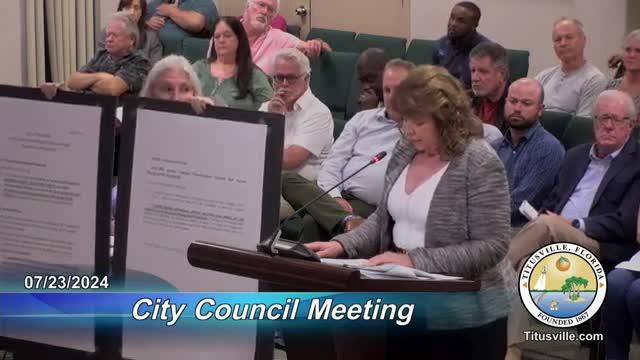City residents rally against controversial high-density development plan
July 24, 2024 | Titusville, Brevard County, Florida

This article was created by AI summarizing key points discussed. AI makes mistakes, so for full details and context, please refer to the video of the full meeting. Please report any errors so we can fix them. Report an error »

In a recent government meeting, significant concerns were raised regarding a proposed high-density residential development in Titusville, Florida, specifically its access routes and potential traffic impacts on local neighborhoods. Residents and city officials debated the appropriateness of the development's access to Wendover Way, a local road, rather than utilizing an existing easement that connects directly to State Road 50, an arterial roadway.
Critics of the development, which includes plans for 304 apartment units, argued that the traffic studies provided by the developers were inadequate and failed to account for the increased traffic that would inevitably flow through residential areas. Many residents expressed skepticism about the claim that no traffic would be generated on local streets, citing the likelihood that residents would use Wendover Way to access nearby commercial areas, including Walmart and Home Depot.
The meeting highlighted a specific point of contention: the city’s planning standards require that developments of this nature must have direct access to arterial or collector roads to avoid generating traffic on local streets. Residents pointed out that the proposed access plan contradicts these regulations, as Wendover Way is classified as a local road.
Several speakers emphasized the potential negative impacts on the quality of life for existing residents, including increased noise, traffic congestion, and decreased property values. They urged city officials to deny the development proposal, citing the need for a more thorough traffic analysis that includes all relevant road segments.
The discussion also touched on the broader implications of the development, with residents advocating for lower-density alternatives that would be more compatible with the surrounding community. The meeting concluded with a call for further review of the traffic studies and a reconsideration of the development's access points, as community members expressed their desire to protect the integrity of their residential neighborhoods.
Critics of the development, which includes plans for 304 apartment units, argued that the traffic studies provided by the developers were inadequate and failed to account for the increased traffic that would inevitably flow through residential areas. Many residents expressed skepticism about the claim that no traffic would be generated on local streets, citing the likelihood that residents would use Wendover Way to access nearby commercial areas, including Walmart and Home Depot.
The meeting highlighted a specific point of contention: the city’s planning standards require that developments of this nature must have direct access to arterial or collector roads to avoid generating traffic on local streets. Residents pointed out that the proposed access plan contradicts these regulations, as Wendover Way is classified as a local road.
Several speakers emphasized the potential negative impacts on the quality of life for existing residents, including increased noise, traffic congestion, and decreased property values. They urged city officials to deny the development proposal, citing the need for a more thorough traffic analysis that includes all relevant road segments.
The discussion also touched on the broader implications of the development, with residents advocating for lower-density alternatives that would be more compatible with the surrounding community. The meeting concluded with a call for further review of the traffic studies and a reconsideration of the development's access points, as community members expressed their desire to protect the integrity of their residential neighborhoods.
View full meeting
This article is based on a recent meeting—watch the full video and explore the complete transcript for deeper insights into the discussion.
View full meeting